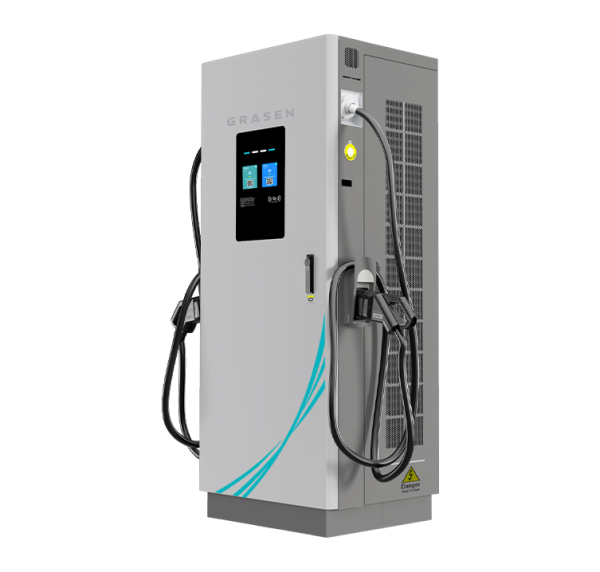As the world increasingly embraces electric vehicles (EVs), the need for faster, more efficient charging solutions has become paramount. One of the most significant advancements in EV charging technology is the development of the DC Fast Charger. This cutting-edge technology promises to reduce charging times dramatically, helping to overcome one of the biggest hurdles to mass EV adoption—long charging periods. Let’s dive into the details of DC Fast Charger, their benefits, and how they are shaping the future of electric mobility.
What is a DC Fast Charger?
A DC Fast Charger (also known as Level 3 charger) is a high-powered electric vehicle charging station that converts alternating current (AC) from the grid into direct current (DC) to rapidly charge an EV’s battery. Unlike standard AC chargers, which charge vehicles at a slower rate, DC Fast Chargers supply DC directly to the EV’s battery, bypassing the car’s onboard converter and reducing charging times significantly.
While AC chargers are common in residential and public charging locations (Level 1 and Level 2), DC Fast Chargers are typically found at dedicated public charging stations along highways, in urban centers, and at high-traffic locations where drivers need a quick charge to continue their journey.
How Does a DC Fast Charger Work?
DC Fast Chargers use specialized hardware and powerful charging protocols to deliver high-voltage DC power to EV batteries. The key components of a DC Fast Charging system include:
- Power Supply Unit: Converts AC from the grid into high-voltage DC power.
- Charging Cable: Transfers the DC power to the vehicle’s battery.
- Charging Station Control: Manages the communication between the charger and the vehicle, ensuring that the battery is charged efficiently and safely.
These chargers operate at much higher power levels compared to their AC counterparts, with outputs ranging from 50 kW to over 350 kW, depending on the station and the vehicle’s charging capabilities.
Advantages of DC Fast Chargers
- Speed: The primary advantage of DC Fast Chargers is speed. While AC Level 1 chargers might take several hours to fully charge an EV, DC Fast Chargers can restore up to 80% of an EV’s battery in as little as 20 to 30 minutes, depending on the power output and battery capacity. This makes them ideal for long-distance travel and quick top-ups.
- Convenience: For drivers who are on the go, DC Fast Chargers offer a fast, convenient way to get back on the road without having to wait hours for their vehicle to charge. These stations are often located along highways, in commercial hubs, and near shopping centers, making them easily accessible.
- Range Confidence: EV drivers often worry about range anxiety—the fear of running out of battery power on a long trip. DC Fast Chargers help alleviate this concern by allowing for quick recharges, ensuring that drivers can travel longer distances without extensive delays.
- Future-Proofing: As EVs continue to evolve and batteries become more powerful, DC Fast Chargers will need to adapt to meet the growing charging demands. These chargers are built to accommodate high-output systems, making them future-proof for upcoming advancements in battery technology.
Challenges of DC Fast Chargers
- Infrastructure Cost: Installing and maintaining DC Fast Charging stations can be expensive due to the high-voltage equipment and the need for a robust electrical grid. While governments and private companies are investing heavily in expanding charging networks, the cost remains a barrier to widespread adoption.
- Vehicle Compatibility: Not all EVs are equipped to handle high-powered DC fast charging. The charging capabilities of an EV depend on its battery architecture, and some vehicles may not be able to take full advantage of DC Fast Chargers. However, many modern EVs are designed to support these chargers, and the number of compatible models is growing.
- Grid Strain: DC Fast Charging stations consume significant amounts of electricity, which can place additional strain on local power grids, especially in high-traffic areas. Managing this load will require smart grid technologies and careful planning to ensure reliable service.
- Standardization Issues: Although there are several global standards for DC Fast Charging (such as CHAdeMO, CCS, and Tesla Supercharger), the lack of universal compatibility across different charging networks and EV manufacturers can cause confusion for drivers. Standardization efforts are underway, but the situation is still evolving.
The Future of DC Fast Charging
The demand for DC Fast Chargers is expected to grow significantly as more people switch to electric vehicles. Governments, utility companies, and private entities are investing in the development of charging infrastructure to support this shift. This includes the construction of more fast charging stations along highways, at commercial centers, and even in residential areas.
In addition to expanding the infrastructure, there is ongoing research into improving the efficiency of DC Fast Chargers. Future developments may include:
- Higher Power Output: With output levels exceeding 350 kW, the next generation of DC Fast Chargers could charge EVs even faster, making it possible to recharge in just 10-15 minutes.
- Wireless Charging: Although still in the experimental phase, wireless or inductive charging could eliminate the need for cables and make charging more convenient.
- Smart Charging: Integration with smart grids and dynamic pricing systems could help optimize the charging process, ensuring that EVs are charged when electricity demand is lower, thereby reducing costs and grid strain.
Conclusion
DC Fast Chargers are crucial to the growth of the electric vehicle market. Their ability to provide quick and efficient charging is helping to address range anxiety and making long-distance travel more practical for EV owners.
